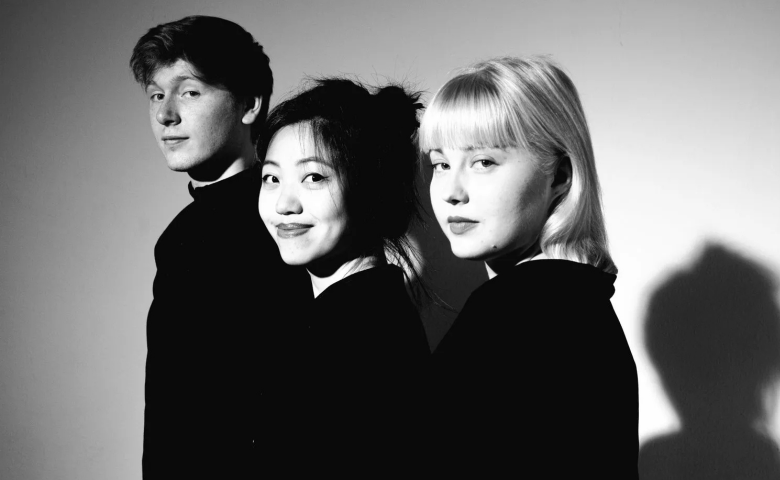Paddington Trio: Music by Sam Perkin, Mendelssohn & Haydn
Wigmore Hall

THE PADDINGTON TRIO will perform Piano trios by Sam Perkin, Haydn and Mendelssohn.
The Paddington Trio is presented today by The Parkhouse Award, which the ensemble won in 2023 at Wigmore Hall having impressed the distinguished jury with its energetic communication, imaginative programming and refined ensemble playing.
The trio has also won the 2020 Royal Over-Seas League Competition Strings & Piano Ensemble, the New Formats Project Prize 2022 in Graz and the Clara Schumann International Competition. The players are currently Chamber Fellows in the Chamber Fellowship Programme at the Royal Northern College of Music.
Starting out together in 2020, the ensemble's mission is to bridge the gap between new listeners and established classical music enthusiasts by welcoming everyone into its living room of musical discovery and shared love of chamber music.
Promoted by the Parkhouse Award.
Programme Note
Sam Perkin's "Freakshow" (2016) has been performed over thirty times worldwide. It is an emotionally wide-ranging exploration of the stars of “The Sideshow”. At times macabre and at times joyful, it is an intriguing suite of curiosities.
"Freakshow" (2016) - Composed by Sam Perkin
Commissioned by Gregynog Festival Wales for Fidelio Trio
1 - The Rat Circus
2 - The Two-Headed Nightingale
3 - The Living Skeleton
4 - The Gentle Giant
5 - The Angel of Death
6 - Pandora’s Basket
7 - The Armless Fiddler
Sam Perkin’s 2016 piano trio was commissioned by the Gwyl Gregynog Festival, the oldest classical music festival in Wales. “Freakshow” was composed in honor of the centenary of the Easter Rising, the 1916 armed Irish insurrection against British rule. The rebellion was soon quashed, sixteen rebels were executed, and 1800 prisoners were transported to the Welsh internment camp at Fron-Goch where they were detained from June to December, 1916. Perkin’s “Freakshow” was inspired by stories of the dismal conditions in the prison camp. According to one account, the entire camp was so overrun with rats that one prisoner went to great lengths to catch and feature them in a "Rat Circus” that he presented for the entertainment of his fellow inmates. The macabre tone of this story prompted Sam Perkin to write a set of musically diverse miniatures that draw on themes of captivity and spectacle as points of departure. “Freakshow” is a set of imaginative musical portraits of historical figures whose physical deformities were exhibited as carnival and circus sideshow spectacles during mid-19th and early 20th centuries.
Each movement represents a different performer:
1. The Rat Circus provides a brief sonic image of the viciously squeaking and skittering rats in the prisoner’s circus at Fron-Goch Internment Camp.
2. The Two-Headed Nightingale is a delicately grotesque waltz evoking a stage performance by the conjoined African American twins, Millie and Christine McCoy, who traveled the world during the mid-19th century as popular song and dance entertainers. Over the course of their lives, they overcame years of slavery, forced medical observation, and degrading participation in fairs and freak shows.
3. The Living Skeleton is a feather-weight musical depiction of Issac W. Sprague whom PT Barnum showcased in the 1860s as “The Original Thin Man” At age 44, Sprague was 5 feet and 6 inches tall but weighed only 43 pounds.
4. The Gentle Giant is a gently ironic, pizzicato portrait of the massive Robert Wadlow, who grew to be the tallest person in recorded history. At the time of his death in 1940, Wadlow had grown to the height of 8 feet, 11.1 inches.
5. The Angel of Death is a hauntingly chorale-like sketch of the malicious Josef Mengele, the fearsome Nazi doctor who performed genetic experiments on captives at Auschwitz. Among his subjects were the seven members of the Ovitz Family, an imprisoned family of Jewish Hungarian dwarves who made their living as entertainers. Mengele kept them alive as subjects for his pseudoscientific experiments on heredity.
6. Pandora’s Basket was inspired by a famous early 20th-century contortionist named Li Yeng. The armless and legless Chinese performer became known as the “Basket Lady of Weijing Province”, since she was small enough to sit in a basket only several inches deep. With its evocative hints of chinoiserie, the movement is the most emotionally far-ranging in the set, vacillating between diaphanous, filigreed textures and more forceful displays of Ravel-like virtuosity.
7. The upbeat final movement, The Armless Fiddler, is a toe-tapping celebration of Carl Herman Unthan, an armless, Prussian-born violinist and actor who learned to play the violin with his feet by strapping the instrument to a stool. He became such an accomplished performer that he appeared as a soloist with many European orchestras and lectured to injured German World War I veterans about how to retrain their legs and feet to take over for their missing upper limbs. In the Armless Fiddler, Sam Perkin creates a jauntily pizzicato Irish jig to summon Unthan’s indomitable spirit.
Notes by Michael Parloff
Parlance Chamber Concerts, Artistic Director
Tickets
This concert is part of the CAVATINA Chamber Music Trust ticket scheme, offering free tickets to those aged 8-25.
Standard tickets £15 plus booking fee. Book online here.
